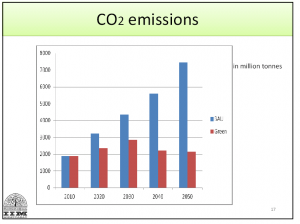 As a developing country with a rapidly increasing growth rate, India’s energy needs and consumption have likewise dramatically risen. This has led to greenhouse gas emissions and air pollution, causing health issues on a local level and climate change on a global one. These negative impacts have led to an ever increasing focus on India’s energy mix and how renewable energies could provide a solution. A study by the Indian Institute of Management Ahmedabad of India has investigated the possible long-term future of India’s energy mix and the role that bioenergy could play.
As a developing country with a rapidly increasing growth rate, India’s energy needs and consumption have likewise dramatically risen. This has led to greenhouse gas emissions and air pollution, causing health issues on a local level and climate change on a global one. These negative impacts have led to an ever increasing focus on India’s energy mix and how renewable energies could provide a solution. A study by the Indian Institute of Management Ahmedabad of India has investigated the possible long-term future of India’s energy mix and the role that bioenergy could play.
The three largest energy consuming sectors are the residential, electrical and transport sectors. Currently biomass within the residential sector is used largely to fuel inefficient cookstoves within homes, while small family type biogas plants are also in use. It makes up 27% of the primary energy supply, showing it to already be well-established. Bioenergy in both the electricity and transport sectors is a relatively new realization, with programmes only being introduced in the early 2000s. There are issues and challenges associated with all three sectors, and the government has implemented policies and programmes for all of them with varying degrees of success.
In order to model the possible energy mix from 2010 to 2050, two different approaches were used: a Business-as-Usual (BAU) scenario, and a Bioenergy (BE) scenario. The former assumes development along a conventional resource intensive path while the latter assumes a much greater focus on bioenergy. While in both scenarios bioenergy is supported by the government, the BE scenario has considerably more governmental support with a developmental as well as technological push.

In both scenarios, the overall energy demand rises to around 2500 tonnes of oil equivalent, while the bioenergy demand also increases – here, however, it is important to note that the share of bioenergy ultimately decreases in both scenarios. While this indicates that the bioenergy share in India’s energy mix is unlikely to increase, other results are more positive. In the BE scenario, there is an overall increase in demand for renewable energy – by 2050, the study suggests that 40% of the energy mix will be from renewable energy sources, which increases to 51% when non-fossil fuels such as nuclear and hydro energy are included. In the BE scenario, the transport sector also sees a significant rise in share and demand compared to the BAU scenario. Overall, though greenhouse gas emissions increase in both scenarios, the greater share of bioenergy in the BE scenario leads to emissions peaking in 2030 and subsequently dropping again. Estimated 2050 CO2 emissions in the BAU scenario are nearly 3.5 times higher.
Bioenergy is currently one of the largest components in India’s energy mix – the other two being coal and oil – though a shift to the more modern biomass fuel sources is necessary. Solar energy also has major potential for the future energy mix due its affordability. NAPCC’s study has clearly shown that if greater emphasis is placed on the role of bioenergy and renewable energies within Indian governmental policy, it is possible to improve India’s energy security and access while simultaneously reducing air pollution, leading to an overall higher quality of life.
This post is based on an paper presented at the 22nd EUBCE and written by Bhaskar K. and Shukla P. R., Indian Institute of Management Ahmedabad. The full paper and slides are published in the conference proceedings and can be downloaded at the link below.


